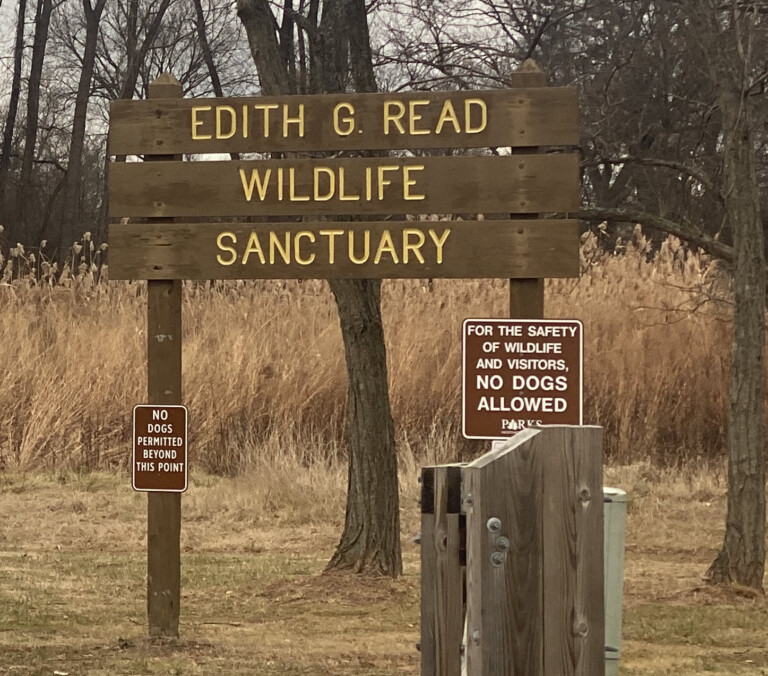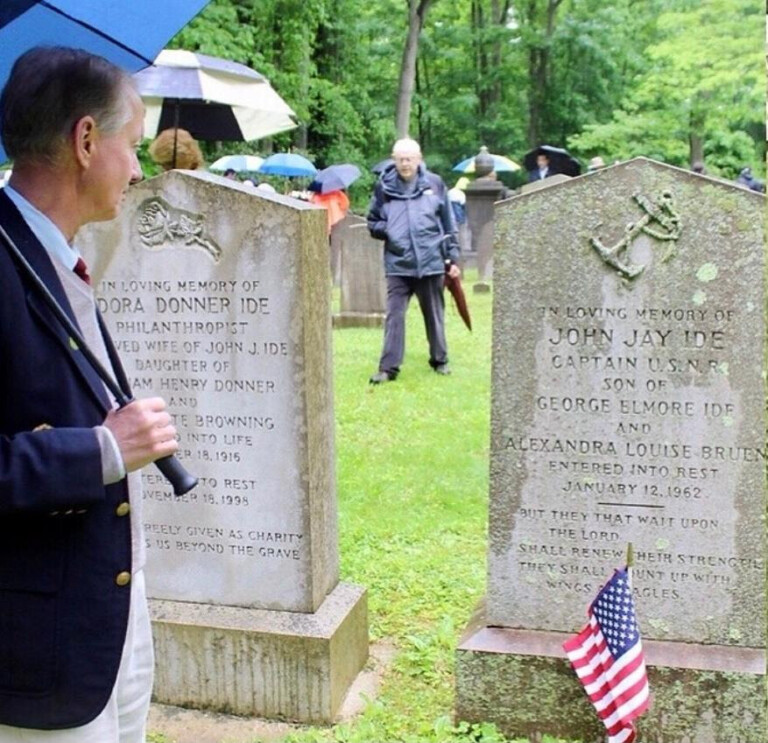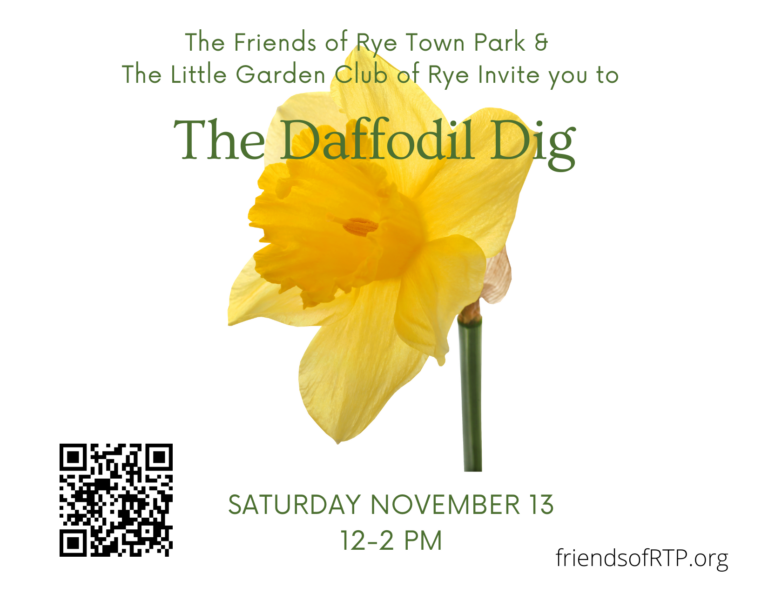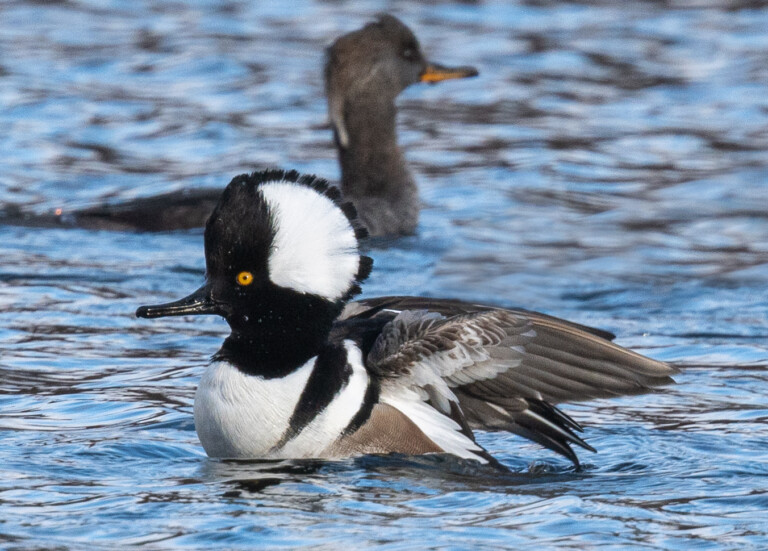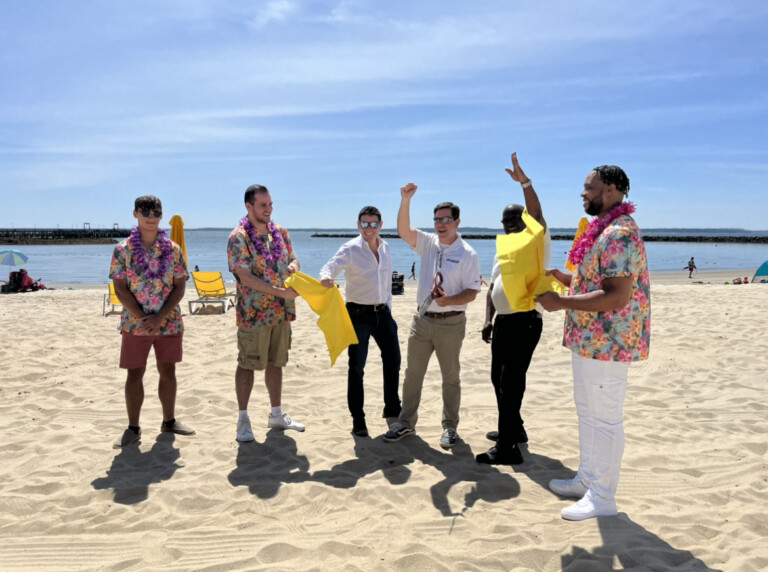Going Native: Gardening with Ecologic’s Dominique Biondi
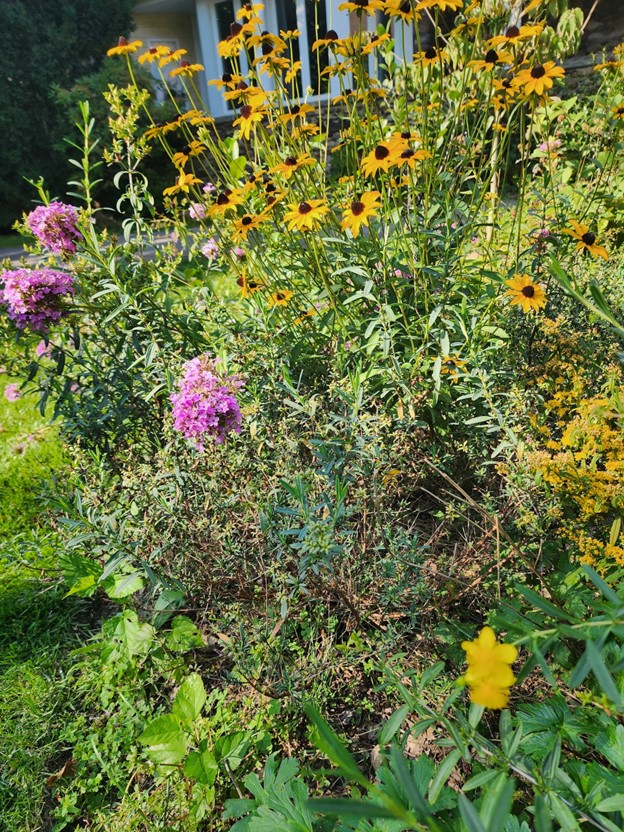
Going Native is a new garden series highlighting the contribution of native plants to building resilient landscapes. In this series, MyRye.com will introduce you to native plant experts that will tell you ways to get started with a small garden patch, a complete property or just a few garden containers.
Today, please meet Dominique Biondi of Operations of Ecologic.
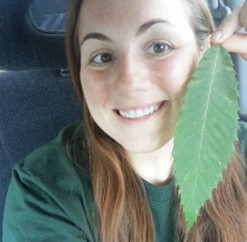
Your name: Dominique Biondi
Your company and role: Ecologic; Sole proprietor/Landscaper
Explain your professional training and education with respect to native plants and ecology.
Biondi: Lifelong nature lover and artist, starting learning as a child helped me become fairly advanced in environmental sciences well before high school. Received my Wildlife Science B.Sc from the absolutely world-changing Paul Smith’s College in the Adirondacks of NY. Habitat loss is a major cause of wildlife decline, so in 2008 learning the appropriate plants to successfully aid their populations was the logical next step. Beyond fortunate to have worked many positions across North America since then with plants and wildlife in stunning environments and with skilled, dedicated researchers. And pleased to now help local Westchester homeowners with dual purpose beautiful and ecologically important gardens since 2019!
Why do you work primarily with native plants?
Biondi: It is as rewarding as it is sound science. In order to create and restore habitats for wildlife, you have to follow the natural requirements: What is supposed to grow here based on x y z? Which plant species can directly save wildlife with food and shelter? And of course keeping people’s different desires of beauty in mind. Luckily for the onlookers, countless plants that answer these questions are gorgeous, both familiar and unique to see in a garden, too.
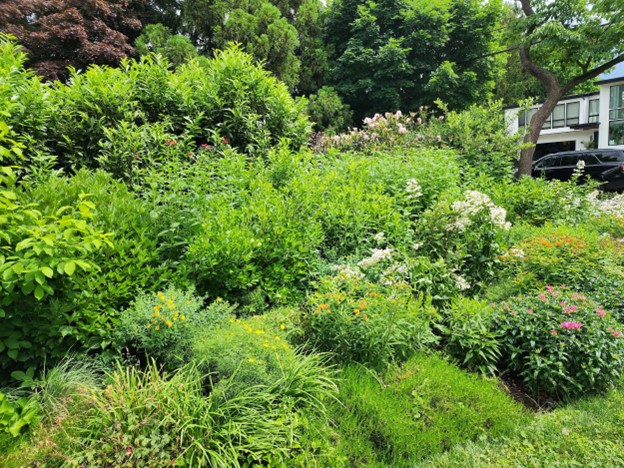
What are some of the benefits of native plants?
Biondi: You can target a specific animal to attract and aid with a certain plant, or offer a broad ranging selection of plants to give everyone a little something! After “babying” (watering deeply) any new plant their first year in the garden and setting them up for success with proper practices, they are largely self-sufficient starting the following year, with some deep waterings during summer droughts. And little to no tedious pruning or maintenance required!
What are invasive and non-native plants?
Biondi: All invasive plant species are non-natives, but not all non-natives are invasive. Invasives differ from non-natives, in that non-natives are not naturally supposed to be growing in a region without some sort of introduction by people (brought over from foreign countries). If you traveled back in time 9,000 years ago, what was growing was all endemic to that area. When certain non-native (introduced) plants reproduce heavily, escape their original planting spot, and rapidly overtake the surrounding land and require humans to control its spread, then it’s invasive. When a native plant spreads profusely like an invasive does, the term is “aggressive native.”
What is a straight native versus a cultivar?
Biondi: A wild plant without any human cultivation is a straight species, looking like and genetically made of its wild parents. A cultivar is like how we made dogs out of wolves: we selected some to breed for a trait we liked (for wolves it was friendliness, for plants, say purple leaves). They are selections of certain plants that differ from the wild “straight” species, and it was amplified by human choice.
If someone is new to native plants, how do you suggest one gets started?
Biondi: Getting an assessment to begin will set you up for success. From there, an educated landscaper should provide you with the best options tailored to your site conditions and goals. A fun thing anyone can do at any time and at any level is read! So much can be learned passively from “native plant garden online groups” as well, they normally have great information and passionate people.
It is the fall season – what are some good action items around fall planting, yard care and thinking ahead to spring?
Biondi: We are lucky to have many leaves in our towns – the best mulch and compost around! Leave lots of leaves raked into “less visible” areas (backyard woodlands, shrubby gardens, under hedges), and mow over other leaves to get chopped leaf bits, perfect to put on your beds for a fertilizing protective mulch. No need to remove in spring, plants will poke through fine and the leaf bits break down. They are high quality, and free. Don’t let them blow away your best garden asset (and baby butterflies you are spending garden money on trying to see!)
Explain four or five of the most common invasive plants in the Rye landscape, and some good native substitutes?
Biondi:
| Common Invasive | Native Substitute(s) | Comments |
| Euonymus alatus (Burning bush) | Aronia arbutifolia (red chokeberry) | Awful threat to our woodlands. |
| Hedera helix (English ivy) | Parthenocissus quinquefolia (virginia creeper) or Lonicera sempervirens (coral honeysuckle) | English ivy kills trees at not just your home, but kills them even faster in forests. |
| Berberis thunbergii (Japanese barberry) | Itea virginica (sweetspire) or Vaccinium corymbosum (blueberry) | Barberry can increase tick populations and is illegal is many places, but stores still sell them. Just like bamboo, an awful invasive now illegal in several towns. |
| Ligustrum (Privet) | Thuja occidentalis Emerald Green (Arborvitae) or Viburnum prunifolium (blackhaw) | Privet is a real bully in our forests. |
| Hibiscus syriacus (rose of sharon) | Hibiscus moscheutos (mallow) | Beloved but a thug. Like the also invasive Buddelia (butterflybush) they are attractive to people but cause loss of diversity. |
Privacy screening with plants is important to many homeowners in Rye – what are good native species to consider for screening projects?
Biondi: A mixture of evergreen and deciduous is my go to. Hedges are my top favorite garden design! Ilex glabra (inkberry) is a lovely evergreen for added privacy. I love a thick wall of Viburnum prunifolium (blackhaw).
What are good resources for people to learn more about natives?
Biondi:
| Resource Name | Detail |
| BONAP | website listing which species are native to where in maps. |
| Native Plants of the Northeast | Book by Donald Leopold |
What are three good local nurseries that specialize and / or have expertise in native plants?
Biondi:
- Rosedale Nurseries in Hawthorne. Large selection of great plants.
- Weaver Gardens in Larchmont. Small Nursery with natives as a focus.
- Tony’s Nursery in Larchmont. Annual buy 1 get 1 with 50% off sale during non summer months.
Tell us about some of your native plant projects in Rye or elsewhere in Westchester County.
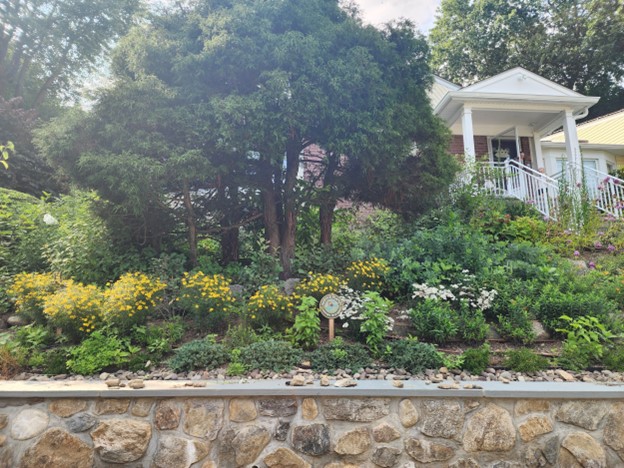
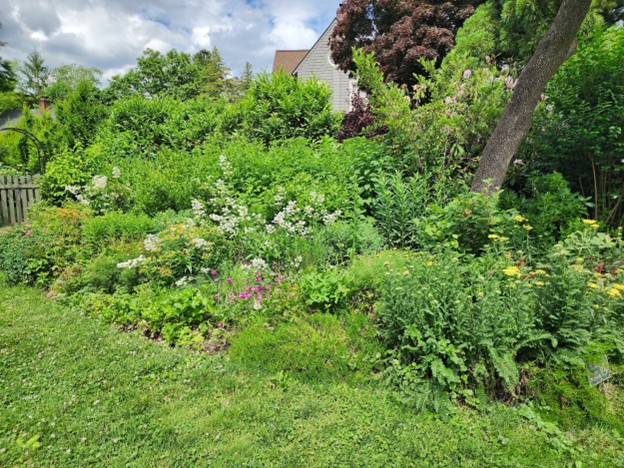
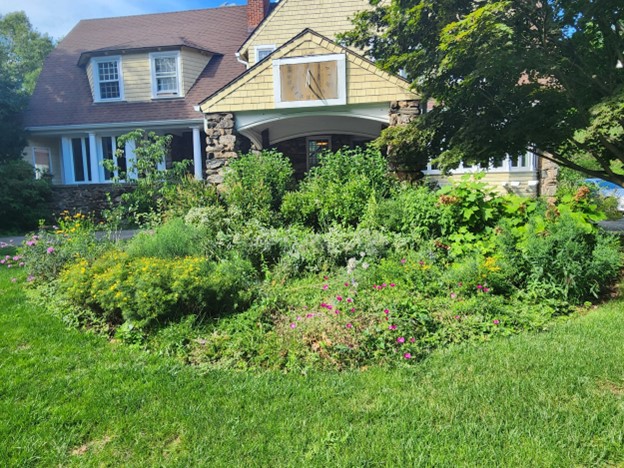
Biondi:
- White Plains terraced gardens. Designed for rabbit resistance, a high visibility front yard in a residential neighborhood that needed “formal nods and tidy beauty” achieved through thoughtful plant groupings and selecting reliable native species.
- Pelham home wildlife gardens. Over six gardens ranging from fancy front yard frequently viewed beds to backyard spaces allowing more wild species to flourish. A great introduction into how natives can represent “business in the front and party in the back!” while retaining an “I can do that, too” feel.
- Pelham Sanctuary gardens. Over seven gardens on all sides of the house focusing on full, lower maintenance designs, with non stop color and interest year long.
Tell us about your services:
How would your friends and family describe you in one word?
Biondi: Sagacious
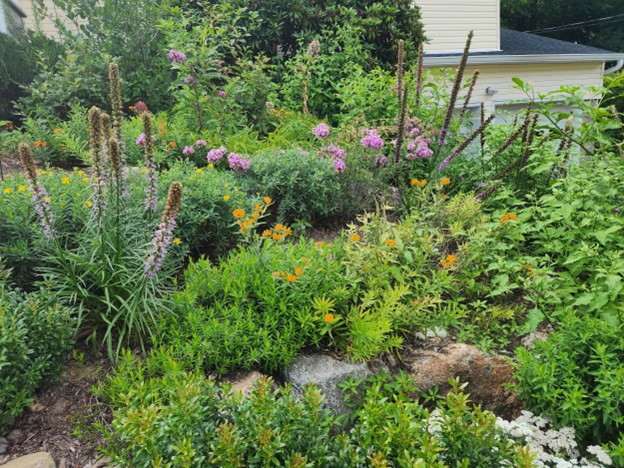
Summarize your career in five sentences or less.
Biondi: Researcher, observer, advisor, and field technician for cross-continent seasonal wildlife positions honed into local habitat garden creation. Designing and assisting installation of gardens that are helpful to wildlife and pretty to look at and easy to maintain. Using ecological science to create functional habitats while appearing to be an attractive, beloved garden. It’s just myself, no company or llc, which works for me just fine! Although my husband does lots to help (I tip well… homemade cinnamon rolls.)
Do you work on residential, government and/or commercial projects?
Biondi: Mostly residential with some school grounds.
How many years have you worked with native plants?
Biondi: Since 2019
Which of the following services do you provide:
Biondi:
| Service | Yes or No | Detail |
| Ecological assessment | Yes | Consultations to see your land, assess current environmental conditions, discuss goals, identify plants, etc. |
| Design with native plants | Yes | All garden designs are comprised of plant species native to the northeast. Using both straight species and thoughtfully selected benign cultivars, the sustainable gardens are created to both attract and benefit wildlife while looking beautiful to people with minimal maintenance needed. |
| Installation of native plants | Yes | I personally install very small scale gardens, and offer logistics with hired landscape laborers from licensed companies to install your larger projects. |
| Invasive species management | Yes | Identification, action plans, timelines of required steps offered, and offer logistics with hired landscape laborers from licensed companies when receiving a garden design. |
| Organic lawn service, including electric equipment | No | |
| Organic shrub and tree care | No | |
| Other – explain | Yes | Sourcing: locating and selecting the proper plant species for the garden. |
| Other – explain | Yes | Installation logistics and project oversight: coordinating with hired laborers and instructing them on garden planting day on how to place the plants as per design. |
Tell us about you:
Where do you live?
Biondi: Pelham, NY
What do you do with your free time?
Biondi: Explore remote wilderness places across NY, discuss science, math, philosophy, and other interesting topics with my husband over brunch, and sit outside to watch little birds hop about a big tree while the breeze blows.
Thanks Dominique!
Learn more.
Biondi’s bio:
I’m Doe. I focus on Habitat Restoration Ecology and Sustainable Landscape Design. Since youth, I’ve been fortunate enough to be well rounded in wildlife studies, with my goal of pursuing a meaningful job helping animals. Science has always been a strong point in academics and a top interest, and I am happy to be able to enjoy it through work as well as leisure. It has brought me to remote environments, lived amongst breathtaking scenery, and truly fun work with like minded colleagues. Being able to add my efforts towards a better world, while still having free time with family, is the best outcome I could think of work-wise.

